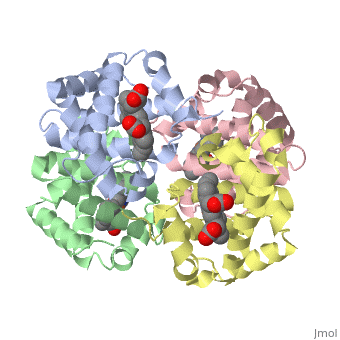Introduction to protein structure
Levels of Protein StructureLevels of Protein Structure
Proteins are condensation polymers of amino acids. The is the amino acid sequence. The is the local structure over short distances. This level of structure is stabilized by along the . These secondary structures to form the overall form of the entire peptide chain, called the . Some proteins, such as the displayed hemoglobin molecule, have more than one polypeptide chain that associate to form the functional unit of the protein; this is called . Questions based upon these scenes: What is the primary sequence shown in the first link? Is the secondary structure shown an alpha helix or beta sheet? The ith C=O of the backbone is hydrogen bonded to which N(-H) (use i +/- # to represent the number)? What atom does this program NOT show? What color is used to represent alpha helices? How many alpha helices are present in the single peptide chain shown? How many polypeptide chains make up the quaternary structure?
Ways of representing protein structureProtein structures can be displayed in many different ways. In models, all of the non-hydrogen atoms are shown as spheres with their van der Waals radii. In the model, the atoms are shown as smaller balls, connected by sticks; this is further simplified in the model, which only shows the bonds between atoms. shows only the N-Calpha-C=O repeating unit; the representation shows the secondary structures. Questions based upon these scenes: Which of these representations would be best for showing... --the secondary structures present in a molecule? --Channels, holes, or pockets in a protein? --Residues in the active site of an enzyme? Explain your answers. Secondary Structures |
| ||||||||||
